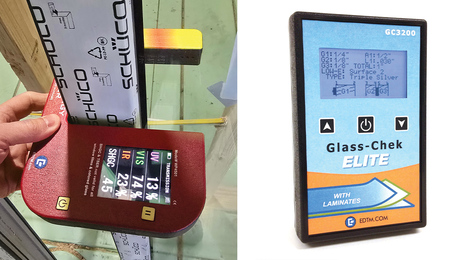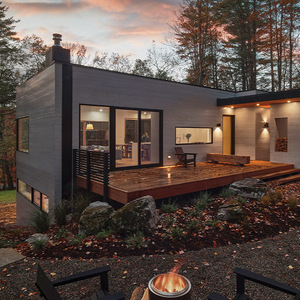Re-using a big wire for smaller amps?
Continuing the demolition of my kitchen for a total reno. I won’t be needing the 50-amp 240V circuit that fed the old electric oven, since the new range is all-gas and in a different location.
However, the big cable comes up through the floor in a convenient spot to supply the outlets, disposal, and microwave for the new island. Is it legal to switch the cable to two 20-amp breakers and re-use it? Would the wires even fit into a 20-amp breaker anyway?
If so, I could avoid the nuisance of running two new lines under the floor (the basement ceiling beneath is finished).



















Replies
There's nothing wrong with using a wire gauge that's larger than necessary, as long as it's small enough to fit the devices at each end (assuming the existing wire has two conductors with a ground wire. Depending on the insulation color of the existing cable you may have to wrap the ends of one or both conductors with tape to get the right color code.)
A 50 amp circuit is probably using #8 wire, and according to my Square D catalog their standard 15 to 30 amp circuit breakers for a residential panel will work with up to #8 wire (other brands of circuit breakers may be different, you'd have to check that out.)
However, I believe most receptacles will only work with up to #10 wire, so the #8 will be too large. You could bring the #8 into a nearby junction box and connect a short length of smaller Romex to it, using appropriately sized wire nuts, but that's a lot of extra fooling around. That #8 wire is pretty big and stiff, and it can be difficult to work with and to fit into a junction box. It may be just as easy to replace it when everything is said and done.
Edited to add: I re-read your post and started wondering...are you talking about putting in a small subpanel with circuit breakers in the kitchen where the #8 wire presently ends, and then extending a couple 120vac circuits from there? That could work.
If the #8 cable has two conductors and a ground wire the subpanel could be only 120vac (and you'd have to change the existing 240vac breaker back in the main panel for a 120vac one); if it has three conductors and a ground (so you have a neutral wire) the subpanel could be 240vac and you can leave the connections in the main panel alone.
Still, it may well be a lot of monkeying around for what you get out of trying to save the wire.
Edited 8/21/2006 1:48 pm ET by Stuart
Good call... I like the sub-pannel idea."When Fascism comes to America, it will be wrapped in the flag and carrying a cross."-Sinclair Lewis
The 8-ga cable is 3 conductors and a ground. I might use a separate junction box below the main box to avoid trying to stuff the #8 into a 20-amp breaker. I don't know if I want to try putting in a satellite breaker box inside the island sink base.
If I run two 20-amp circuits sharing the same "white" neutral wire, the two breakers have to be bridged to flip together, correct?
Thanks for your help!
#8 should fit...
Life is not a journey to the grave with the intention of arriving safely in a pretty and well preserved body, but rather to skid in broadside, thoroughly used up, totally worn out, and loudly proclaiming<!----><!----><!---->
WOW!!! What a Ride!<!----><!---->
Forget the primal scream, just ROAR!!!
That would be correct, use a two pole breaker so both sides will trip if there's an overcurrent condition.
Stuart said, "That would be correct, use a two pole breaker so both sides will trip if there's an overcurrent condition"
Is that a code rule? I do not recall what you say being required. I could be mis-membering.
As Bill posted above, I don't believe it's a code requirement but I think it's a good idea. The main thing is to make sure the two circuits are fed from opposite sides of the panelboard, and that will be assured by using a tandem breaker.
Tandem yes, but the breaker "switches" do not have to be joined to turn both off at same time. Could actually be inconvenient to turn off two circuits at same time, whether by choice or by something tripping one of the circuits.
Not tandem.Tandems are two 1/2 size breakers that fit in one slot and thus are one leg.What you need is a two pole breaker or two single pole breaker with an approved handle tie (if anyone still makes that type or not).Or a Quad breaker.
A quad is two sets of tandems so that the inter two are on different legs and the handles are tied together.
"If I run two 20-amp circuits sharing the same "white" neutral wire, the two breakers have to be bridged to flip together, correct?"No.You have to use a two pole breaker ONLY if any one device (receptacle) has both hot legs on it.But there is nothing wrong with doing it and some recommend it as you then you know that the whole circuit is dead when the breaker is tripped.
If you intend to reuse the wire that was used for your old range, in the panel box splice a # 12 wire to the hot conducters ( they should either be the blacks or a black and a red) and hook it to two 20 amp breakers single pole that are not bridged together (singles). Than on the load side use a junction box that is accessible after the project is finished, do the same to all 3 conductors reduce to # 12 ( that includes the white) and wire as if it is # 12 from the panel box. The white in the panel box is ok to leave as it is now, since the white only carries the inbalance of the two colored (hot) wires. If you remove the two pole breaker that now supplies the range and change them to two 20 amp singles, they will also be phased correctly. The reason for down sizing the wire in the panel box. that way it will be easy to see that some thing special is going on with the heavy wire (if you sell your house later the next owner or electrican will not reconnect the wires to a 50 amp breaker)